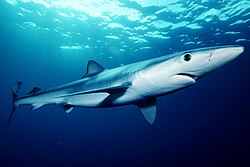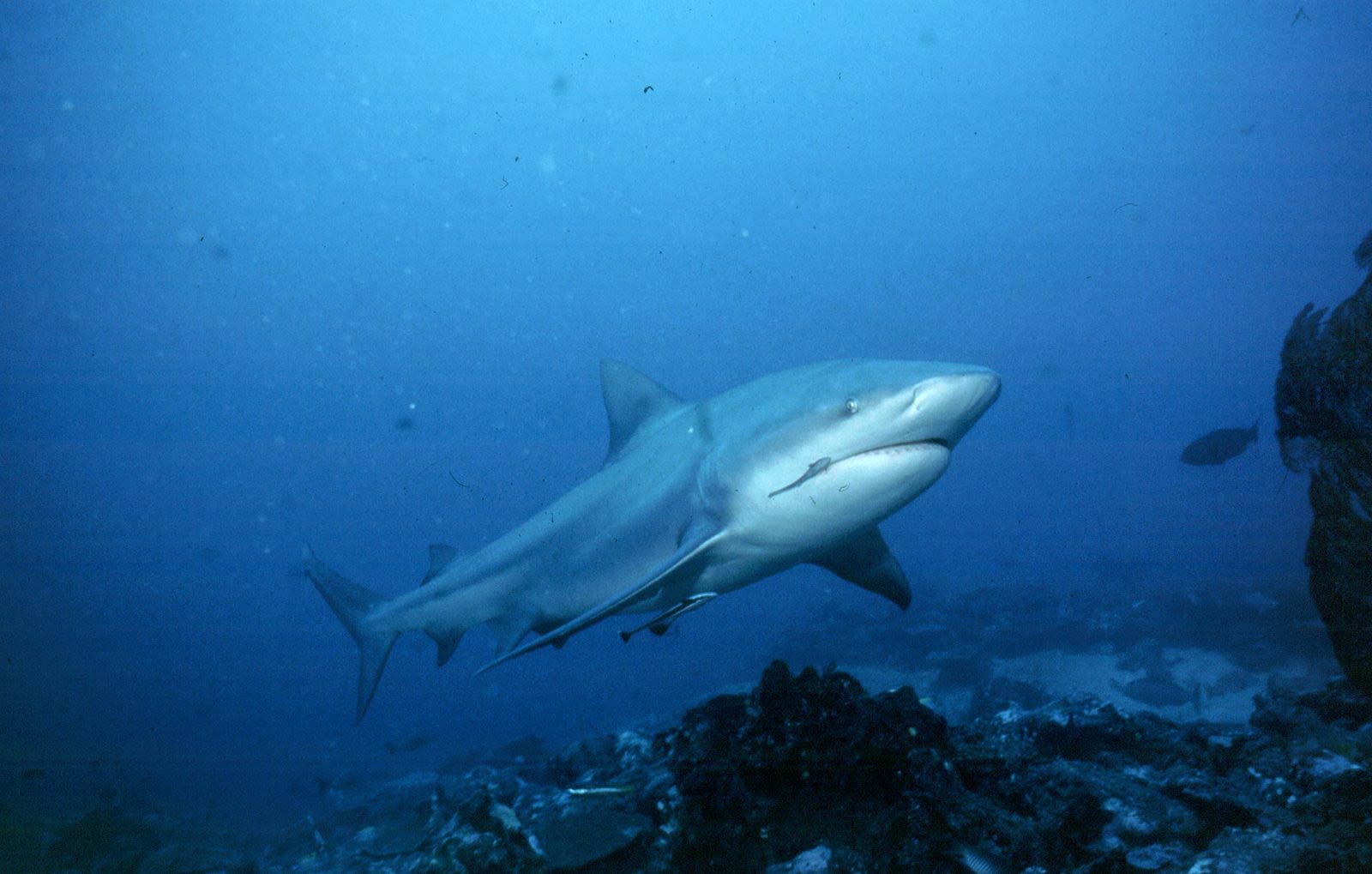Source (google.com.pk)
BLUE SHARK Biography
GENERAL DESCRIPTION
Prionace glauca, the blue shark, is a large, pelagic, indigo-colored shark. It is a sleek shark with long, pointed fins, a pointed snout, and large eyes. Its sleek, tapered body makes it a graceful swimmer. Its elongated caudal fin (tail) provides swimming power as the tail moves side-to-side.
SIZE
Blue sharks grow to be up to 12.5 feet (3.8 m) long.
SWIMMING
The blue shark's sleek, tapered body makes it a graceful swimmer. Its elongated caudal fin (tail) provides swimming power as the tail moves side-to-side. These sharks are among the fastest swimming sharks and can even leap out of the water. They are also probably among the fastest fish. Estimates of their speed varies; some say that they can swim at about 60 miles per hour (97 kph), while more conservative estimates are about 22 mph (35 kph). There hasn't been enough experimentation on their speeds to have an definitive answer.
TEETH
The teeth are pointed and serrated. This enables the shark to catch slippery squid and fish, the mainstay of its diet.
Sharks' teeth are located in rows which rotate into use as needed. The first two rows are used in obtaining prey; the other rows rotate into place as they are needed. As teeth are lost, broken, or worn down, they are replaced by new teeth that rotate into place.
DIET AND FEEDING HABITS
The blue shark's diet consists mostly of squid, but it will eat almost anything; it is an opportunistic feeder.
HABITAT AND DISTRIBUTION
Blue sharks are pelagic; they are found in open waters. Like most pelagic sharks, they are found worldwide.
BLUE SHARK ATTACKS
Blue sharks are considered dangerous, and there have been attacks on people.
REPRODUCTION
Blue sharks are viviparous. Litters consist of 4 to 135 pups; the number of pups increases as the size of the mother increases. The gestation period is almost 1 year. Females are mature at 5 years old.
MIGRATION
Atlantic blue sharks migrate across the Atlantic Ocean each year, following the warm Gulf Stream waters on their eastward trip. They travel a circuit from the Caribbean Sea, along the coast of the USA, east to Europe, south to the African coast, and back to the Caribbean.
SOCIAL GROUPS
Blue sharks often form large, all-male or all-female schools (groups) which contain sharks that are about the same size. No one knowns why they do this.
POPULATION COUNT
The blue shark is classified as low risk/near endangered.
BLUE SHARK CLASSIFICATION
Kingdom Animalia (animals)
Phylum Chordata
SubPhylum Vertebrata (vertebrates)
Class Chondrichthyes (cartilaginous fish)
Subclass Elasmobranchii (sharks and rays)
Order Carcharhiniformes
Family Carcharhinidae
Genus Prionace
Species glauca









BLUE SHARK Biography
GENERAL DESCRIPTION
Prionace glauca, the blue shark, is a large, pelagic, indigo-colored shark. It is a sleek shark with long, pointed fins, a pointed snout, and large eyes. Its sleek, tapered body makes it a graceful swimmer. Its elongated caudal fin (tail) provides swimming power as the tail moves side-to-side.
SIZE
Blue sharks grow to be up to 12.5 feet (3.8 m) long.
SWIMMING
The blue shark's sleek, tapered body makes it a graceful swimmer. Its elongated caudal fin (tail) provides swimming power as the tail moves side-to-side. These sharks are among the fastest swimming sharks and can even leap out of the water. They are also probably among the fastest fish. Estimates of their speed varies; some say that they can swim at about 60 miles per hour (97 kph), while more conservative estimates are about 22 mph (35 kph). There hasn't been enough experimentation on their speeds to have an definitive answer.
TEETH
The teeth are pointed and serrated. This enables the shark to catch slippery squid and fish, the mainstay of its diet.
Sharks' teeth are located in rows which rotate into use as needed. The first two rows are used in obtaining prey; the other rows rotate into place as they are needed. As teeth are lost, broken, or worn down, they are replaced by new teeth that rotate into place.
DIET AND FEEDING HABITS
The blue shark's diet consists mostly of squid, but it will eat almost anything; it is an opportunistic feeder.
HABITAT AND DISTRIBUTION
Blue sharks are pelagic; they are found in open waters. Like most pelagic sharks, they are found worldwide.
BLUE SHARK ATTACKS
Blue sharks are considered dangerous, and there have been attacks on people.
REPRODUCTION
Blue sharks are viviparous. Litters consist of 4 to 135 pups; the number of pups increases as the size of the mother increases. The gestation period is almost 1 year. Females are mature at 5 years old.
MIGRATION
Atlantic blue sharks migrate across the Atlantic Ocean each year, following the warm Gulf Stream waters on their eastward trip. They travel a circuit from the Caribbean Sea, along the coast of the USA, east to Europe, south to the African coast, and back to the Caribbean.
SOCIAL GROUPS
Blue sharks often form large, all-male or all-female schools (groups) which contain sharks that are about the same size. No one knowns why they do this.
POPULATION COUNT
The blue shark is classified as low risk/near endangered.
BLUE SHARK CLASSIFICATION
Kingdom Animalia (animals)
Phylum Chordata
SubPhylum Vertebrata (vertebrates)
Class Chondrichthyes (cartilaginous fish)
Subclass Elasmobranchii (sharks and rays)
Order Carcharhiniformes
Family Carcharhinidae
Genus Prionace
Species glauca
BLUE SHARK

BLUE SHARK

BLUE SHARK
BLUE SHARK

BLUE SHARK

BLUE SHARK 

BLUE SHARK

BLUE SHARK

BLUE SHARK

BLUE SHARK

BLUE SHARK
No comments:
Post a Comment